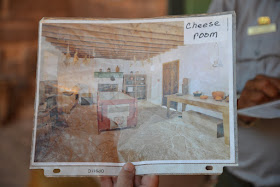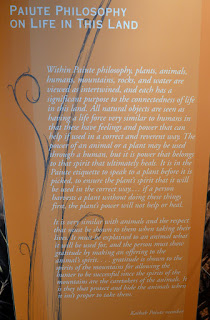From Wiki: Pipe Spring National Monument is a United States National Monument located in the Arizona, rich with American Indian, early explorer, and Mormon pioneer history. Administered by the National Park Service, Pipe Spring was listed on the National Register of Historic Places on October 15, 1966, and the boundaries of the Pipe Spring National Monument Historic District (a portion of the monument) were expanded in October 2000.
This ranger was our guide of the house and grounds. His family (Paiute) has lived in this region for generations. The water of Pipe Spring has made it possible for plants, animals, and people to live in this dry desert region. Ancestral Puebloans and Kaibab Paiute Indians gathered grass seeds, hunted animals, and raised crops near the springs for at least 1,000 years. The spring actually ran through this house, a fortress looking abode, and as such afforded a defense to protect the rich and scarce supply of water.
The above half-dugout stall area kept the livestock in to protect them from the beasts of the night.
Above is the inside courtyard of the house. Some construction was ongoing at the time. Below is a pic of the house as it looked about 140 years ago.
Here are a few more pics the ranger shared with us
From Wiki: Pipe Spring was named by the 1858 Latter-day Saint missionary expedition to the Hopi mesas led by Jacob Hamblin. In the 1860s Mormon pioneers from St. George, Utah, led by James M. Whitmore brought cattle to the area, and a large cattle ranching operation was established. In 1866 the Apache, Navajo and Paiute tribes of the region joined the Utes for the Black Hawk War, and, after they raided Pipe Spring, a protective fort was constructed by 1872 over the main spring. The following year the fort and ranch was purchased by Brigham Young for The Church of Jesus Christ of Latter-day Saints (LDS Church). The LDS Bishop of nearby Grafton, Utah, Anson Perry Winsor, was hired to operate the ranch and maintain the fort, soon called Winsor Castle. This isolated outpost served as a way station for people traveling across the Arizona Strip, that part of Arizona separated from the rest of the state by the Grand Canyon.
Wiki: The house also served as a refuge for polygamist wives during the 1880s and 1890s. The LDS Church lost ownership of the property through penalties involved in the federal Edmunds-Tucker Act of 1887.
Above, an old weaving apparatus.
Ranger and contractors busy making repairs.
From Wiki: Although their way of life was greatly impacted by Mormon settlement, the Paiute Indians continued to live in the area and by 1907 the Kaibab Paiute Indian Reservation was established, surrounding the privately owned Pipe Spring ranch. In 1923, the Pipe Spring ranch was purchased and set aside as a national monument to be memorial of western pioneer life.
Wives bedrooms...
Ranger was talented. He played the organ for us. Below, inside of the stall area.
We found the little museum quite interesting and informative regarding the history of the Spring and the events of the Native Americans and the Mormon movement and homesteading.
Above, the soldier on the right is the ranger that was our guide. He was such a kind man with such a gentle spirit. Below are members of his extended family.
Most of these NA are his family members. The photographs are on loan to the museum.
Miss Nancy "supporting" the NPS through a purchase. Below, a pic of our ranger-guide in Paiute regalia celebrating a Paiute tribal festival.
I asked him if he would remove his hat and glasses for a pic, and he said ok, from one Viet Nam vet to another. We were bonded as Brothers through that mutual experience, albeit unpleasant of course. It is then very apparent of his heritage. He was about 5'5".
Above, his baby pic and pics of his Mother and Grand Mother below. What an experience for us. It was a real treat. We have met so many Native Americans through our journeys all over this great country, and Canada and Alaska as well.
That's a wrap for this blog. It was written and published contemporaneously from Cordele, GA on 1/19/2016. Till our next blog, RVing Beach Bums signing off.


















































No comments:
Post a Comment